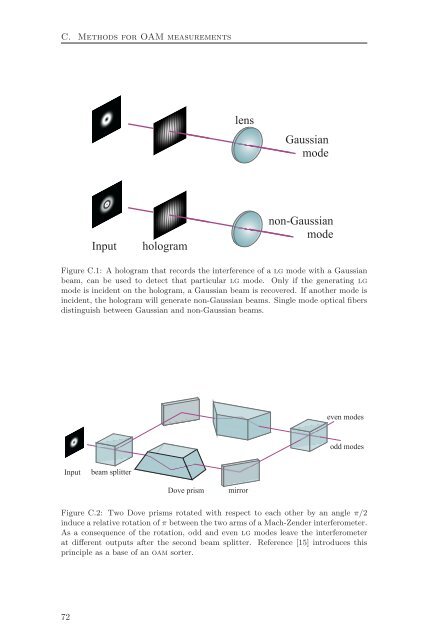C. Methods for OAM measurements Input hologram lens Gaussian mode non-Gaussian mode Figure C.1: A hologram that records the interference of a lg mode with a Gaussian beam, can be used to detect that particular lg mode. Only if the generating lg mode is incident on the hologram, a Gaussian beam is recovered. If another mode is incident, the hologram will generate non-Gaussian beams. Single mode optical fibers distinguish between Gaussian and non-Gaussian beams. Input beam splitter Dove prism mirror even modes odd modes Figure C.2: <strong>Two</strong> Dove prisms rotated with respect to each other by an angle π/2 induce a relative rotation of π between the two arms of a Mach-Zender interferometer. As a consequence of the rotation, odd and even lg modes leave the interferometer at different outputs after the second beam splitter. Reference [15] introduces this principle as a base of an oam sorter. 72
Bibliography [1] M. A. Nielsen and I. L. Chuang, Quantum computation and quantum information. Cambridge, UK: Cambridge University Press, 2000. [2] M. Fox, Quantum Optics, An Introduction. Oxford, UK: Oxford University Press, 2006. [3] S. P. Walborn, S. Pádua, and C. H. Monken, “Hyperentanglement-assisted bell-state analysis,” Phys. Rev. A, vol. 68, p. 042313, 2003. [4] P. G. Kwiat, P. H. Eberhard, A. M. Steinberg, and R. Y. Chiao, “Proposal for a loophole-free bell inequality experiment,” Phys. Rev. A, vol. 49, pp. 3209–3220, 1994. [5] P. J. Mosley, J. S. Lundeen, B. J. Smith, P. Wasylczyk, A. B. U’Ren, C. Silberhorn, and I. A. Walmsley, “Heralded generation of ultrafast single photons in pure quantum states,” Phys. Rev. Lett., vol. 100, p. 133601, 2008. [6] A. Valencia, A. Ceré, X. Shi, G. Molina-Terriza, and J. P. Torres, “Shaping the waveform of entangled photons,” Phys. Rev. Lett., vol. 99, p. 243601, 2007. [7] A. Mair, A. Vaziri, G. Weihs, and A. Zeilinger, “Entanglement of the orbital angular momentum states of photons,” Nature, vol. 412, pp. 313– 316, 2001. [8] S. Franke-Arnold, S. M. Barnett, M. J. Padgett, and L. Allen, “<strong>Two</strong>photon entanglement of orbital angular momentum states,” Phys. Rev. A, vol. 65, p. 033823, 2002. [9] G. Molina-Terriza, J. P. Torres, and L. Torner, “Twisted photons,” Nature Phys., vol. 3, p. 305, 2007. [10] S. P. Walborn and C. H. Monken, “Transverse spatial entanglement in parametric down-conversion,” Phys. Rev. A, vol. 76, p. 062305, 2007. [11] C. K. Law and J. H. Eberly, “Analysis and interpretation of high transverse entanglement in optical parametric down conversion,” Phys. Rev. Lett., vol. 92, p. 127903, 2004. [12] J. T. Barreiro, N. K. Langford, N. A. Peters, and P. G. Kwiat, “Generation of hyperentangled photon pairs,” Phys. Rev. Lett., vol. 95, p. 260501, 2005. 73



